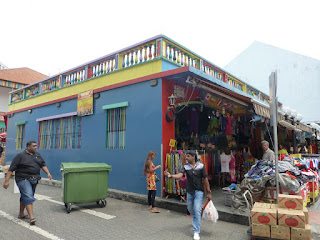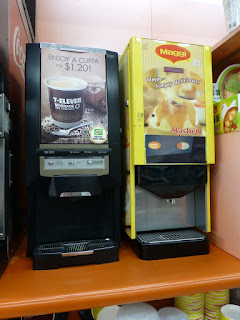I have to admit that I'm a bit at a disadvantage when it comes to verifying the authenticity of ethnic neighborhoods. After living in Japan for a while, I can say that Japantown in San Francisco is pretty good. But I've never been to China or India, so visiting Chinatown and Little India in Singapore doesn't give me anything other than the hope to get a feel for each country's culture.
That said, it was obvious that Chinatown was geared toward tourists. Hong Kong is westernized China, but it did have some realness to it... and Chinatown was not quite real. I'm not saying it's bad. But it's touristy.
But I quickly appreciated the sights, sounds, and smells I encountered when I traveled to Little India.Yes, you can buy Indian clothing. But this shop is there for Indians.
There are food markets which had Indian shoppers browsing.
There were a lot of those flower things. I believe I missed Deepavali, which is a Hindu festival, by a week.
Little India is located a bit further from downtown Singapore, and it's full of Indians going about their daily lives.
One of the best parts of visiting this neighborhood was peeking down the back alleys. It was more real. Trash, carts, people hanging out talking.
Chander Road is the heart of the neighborhood. You'll find some restaurants and tourist attractions here or nearby.
The main streets running around and through the neighborhood are full of shops selling pretty much everything. Some stores are for tourists, but most are practical. It's like the Indian version of Mission Street in San Francisco.
The stores are great!
Interesting sign partly for the subject matter, and partly for the inclusion of five languages.
This is Sri Veeramakaliamman Temple. Don't ask me how to pronounce that.
It is a Hindu temple with elaborate decorative elements. It was closed in preparation for Deepavali but I could enjoy the outside.
Above are some detail photos of the decoration.
The historic buildings here are still in the same general style as you see around the rest of town.
A little more realness that makes this neighborhood so enjoyable.
If you're looking for some good Indian food, you have a lot of choices here. Plus, the stores have a lot of cheap goods - clothing, decorations, and rugs (see the photo below).
I started in the southwest corner of the neighborhood: Sungei Road (Bukit Timah Road) and Race Course Road. Serangoon Road runs north-south and is the commercial center of the area. Just wander and see what you find!






































































